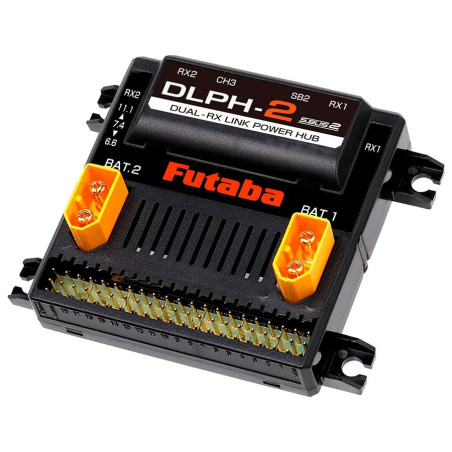





The DLPH-2 receiver power and backup system allows switching power from a pair of LiFe or LiPo batteries and communication between two Futaba S.BUS2 receivers, or with an attached GYA553 aircraft gyro. It provides power to as many as 18 high-pull servos (60A max total) and switching between the main and backup Futaba S.BUS2 receivers in case of signal loss, and allows telemetry monitoring of the voltage of both batteries powering the Futaba transmitter display. The DLPH-2 is equipped with four legs with silent blocks for easy installation in the model.
Operating modes and PWM output channel assignments
Using a compatible transmitter (T32MZ, T32MZ-WC, T16IZ, T16IZ SUPER, T26SZ with the latest software version), it is possible to select DLPH-2 operating modes and assign output channels:
Power supply system
The power supply uses a pair of (identical) 2S LiFe or LiPo batteries; the DLPH-2 ensures even discharge of both - the on-board electronics are always powered by the battery with the higher voltage. The voltage at the outputs for the servos corresponds to the voltage of the power batteries - that is, when using 2S LiPo batteries, high voltage (HV) servos must be used, when powering a pair of LiFe batteries, classic servos can also be used . The DLPH-2 is equipped with an electronic power switch - it can be turned on and off with an external mechanical switch (the DLPH-2 will remain on even if the external switch is disconnected or its wires are broken). The DLPH-2 also supplies power to connected S.BUS2 receivers (5 V).
Note: Due to the electronic switch between power batteries and servo output sockets, it is necessary to connect a PAD reverse current absorber (min. 1 per 8 servos) when using Hitec HSB series AC servos.
Receiver power system
A pair of Futaba S.BUS2 receivers are connected to the DLPH-2 via S.BUS2 ports (they do not have to be of the same type); a backup system provides a switchover to the backup receiver in case the main receiver loses transmitter signal or is subjected to strong interference. When normal operation is restored, it switches back to the main receiver. When using a transmitter that supports the dual receiver function (Dual Receiver), the main receiver is paired with the transmitter as receiver 1 and the backup receiver as receiver 2. For a transmitter that does not support this function, the main Receiver is first paired with the transmitter and then with the backup receiver.
Telemetry function
The DLPH-2 allows connection of all Futaba telemetry sensors via the S.BUS2 port. In addition, it acts as a dual voltage sensor (default start address 6) allowing the voltage of both supply batteries to be monitored on the transmitter's display, and providing a low voltage warning signal (this function is not available in single receiver mode with the GYA553 gyro connected).
DLPH-2 inputs and outputs
The DLPH-2 provides power and connections for servos and other devices, including gyroscopes, telemetry sensors, etc., so receivers are connected only through the S.BUS2 ports - no servos or other devices are connected to them.
DLPH-2 kit includes: external switch, 3 receiver connection cables, installation accessories.
Technical data:
*Follow the instruction manual included with the product.